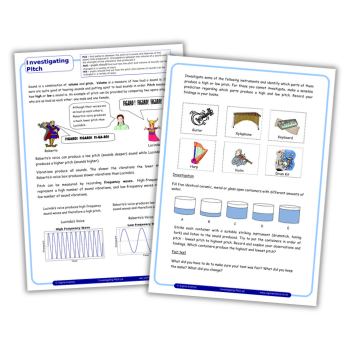This pitch and volume Year 4 worksheet explains that sound is a combination of volume and pitch, and explores the science of the latter by looking at frequency waves.
It asks children to investigate a guitar, a xylophone, a keyboard, a harp, a violin and a drum kit to see what affects pitch. Which parts make a high or low pitch? For instruments pupils cannot investigate hands-on, they can make sensible predictions.
Pitch investigation
Fill five identical containers with different amounts of water. Strike each container and listen to the sound. Put the containers in order of pitch. Children need to record and explain their observations and findings.
How did they make sure the test was fair? What did they keep the same or change?
Pitch and volume Year 4 curriculum
Here are the expectations for Year 4 students in relation to sound and pitch:
- Sound sources:
- Recognise that vibrating objects produce sound which can travel through different mediums, including air, water, and solids.
- Pitch:
- Explore and identify how you can change the pitch of a sound in various ways, for example, by changing the size or tension of a vibrating object.
- Musical instruments:
- Investigate and identify how musical instruments produce different sounds and explore the role of factors such as the size and tension of strings, the length of tubes, and the size of membranes in producing different pitches.
- Ear and hearing:
- Develop an understanding of how the ear works and how sound is detected and processed.
- Recording and analysing sounds:
- Use simple equipment to record and analyse sounds, exploring how changes in pitch and volume can be observed.
Find out more about Sigma Science.











